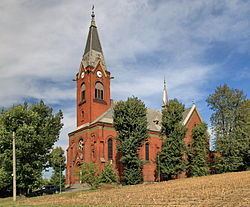District Karviná Postal code 735 34 Area 13.87 km² Population 1,828 (2012) Team SK Stonava | First mentioned 1388 Elevation 193 m Local time Tuesday 2:35 PM | |
 | ||
Weather 19°C, Wind W at 13 km/h, 30% Humidity | ||
Stonava (Polish: Stonawa , German: Steinau) is a village in Karviná District, Moravian-Silesian Region, Czech Republic, on the Stonávka River. It has a population of 1,855 (2006), 25.8% of the population are the Poles. It lies in the historical region of Cieszyn Silesia.
Contents
Map of Stonava, Czechia
The name is of topographic origin, derived from the older name of a local Stonávka/Stonawa River, which itself denoted a murmuring river.
History
The village could have been first mentioned in 1388 as Stoena (Stozna?). As Stonawa it was then mentioned in 1432, a German name Steinau appeared in the 17th century.
Politically the village belonged then to the Duchy of Teschen, formed in 1290 in the process of feudal fragmentation of Poland and was ruled by a local branch of Silesian Piast dynasty. In 1327 the duchy became a fee of the Kingdom of Bohemia, which after 1526 became a part of the Habsburg Monarchy.
The village became a seat of a Catholic parish, mentioned in the register of Peter's Pence payment from 1447 among the 50 parishes of Teschen deanery as Stinavia. After the 1540s Protestant Reformation prevailed in the Duchy of Teschen and a local Catholic church was taken over by Lutherans. It was taken from them (as one from around fifty buildings in the region) by a special commission and given back to the Roman Catholic Church on 26 March 1654.
After the Revolutions of 1848 in the Austrian Empire, a modern municipal division was introduced in the re-established Austrian Silesia. The village as a municipality was subscribed at least since 1880 to political district and legal district of Freistadt.
According to the censuses conducted in 1880, 1890, 1900 and 1910 the population of the municipality grew from 2,040 in 1880 to 3,952 in 1910. In terms of the language spoken colloquially the majority were Polish-speakers (growing from 90.1% in 1880 to 99% in 1910), accompanied by Czech-speakers (at most 158 or 7.8% in 1880, then dropping to between 0.1% and 0.4%) and German-speakers (at most 43 or 2.1% in 1880). In terms of religion, in 1910 the majority were Roman Catholics (77.7%), followed by Protestants (21.1%), 3 Jews and 42 others. The village was also traditionally inhabited by Silesian Lachs, speaking Cieszyn Silesian dialect, additionally industrial growth lured a large influx of migrant workers, mostly from western Galicia.
After World War I, the fall of Austria-Hungary, the Polish–Czechoslovak War and the division of Cieszyn Silesia in 1920, the village became a part of Czechoslovakia. Following the Munich Agreement, in October 1938 together with the Zaolzie region it was annexed by Poland, administratively organised in Frysztat County of Silesian Voivodeship. The village was then annexed by Nazi Germany at the beginning of World War II. After the war it was restored to Czechoslovakia.
